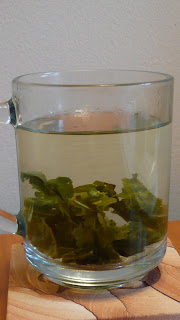
Introduction and index of these experiment series of Gongfu vs. mug brewing is here.
Mug Brewing:
I tried mug brewing of the greener style Yong Chun Fo Shou a few weeks ago, and logged it on Steepster.
 Brewed in mug, the tea is very enjoyable. But flavor is much lighter than in Gongfu brewing. However, I was conservative in leaf amount for that mug brewing session, as seen in the photo. I counted 15 grains of tea leaves and threw them in the mug. Now I think 25 leaf grains probably is a better amount for mug brewing. In mug brewing, the flavor is light in one dimension but more prominent in another sense. The tongue taste is not strong. However, the tea does give a prominent vegetal and metallic taste. I think, very possibly green tea lovers would enjoy this tea more, mug brewed.
Brewed in mug, the tea is very enjoyable. But flavor is much lighter than in Gongfu brewing. However, I was conservative in leaf amount for that mug brewing session, as seen in the photo. I counted 15 grains of tea leaves and threw them in the mug. Now I think 25 leaf grains probably is a better amount for mug brewing. In mug brewing, the flavor is light in one dimension but more prominent in another sense. The tongue taste is not strong. However, the tea does give a prominent vegetal and metallic taste. I think, very possibly green tea lovers would enjoy this tea more, mug brewed.
Gongfu Brewing:
Overall, I prefer Gongfu brewing much more for this tea. With more leaves brewed in a smaller vessel, the flavor is more condensed, and the cultivar characteristics of this tea stands out. This tea is called Fo Shou (Buddha Hand). The tea is named after Chinese bergamot. Bergamot in China is not an edible fruit, but was traditionally used as a perfuming fruit. Bergamot is produced in Fujian, but the fruit was extensively used in affluent families throughout China. The fruit would be cut in halves and presented in the sitting room of the family, as a decoration and an aroma source.
The origin of Fo Shou tea cultivar is a mystery. Many people say it was obtained by engrafting tea tree with Fo Shou (bergamot) tree - before I got my Fo Shou oolong for the first time, just this idea of engrafting fascinated me. Bergamot is from the plant family of Rutaceae, genus citrus. Most of my favorite fragrant essential oils are from this family! The engrafting theory of Fo Shou oolong has never been proved. But the characteristics of this tea do remind a drinker of fragrance of Fo Shou fruits.
When I brew this tea in a small gaiwan, I use a 60ml (2oz.) gaiwan, and lay 2 layers of tea leaf grains at the bottom of the gaiwan. After a warm-up infusion, the first a few infusions are 20 seconds each. After the first infusion, tea leaves expand to half volume of the gaiwan (showed in above picture). And after the 5-7th infusion, the tea leaves expand to loosely fill the entire gaiwan (showed in the picture below).
 A bonus of Gongfu brewing is, at the end, you can always invert the gaiwan and let leaves pile up on the lid, so that a few minutes can be dedicated to leaf appreciation. Greener style southern Fujian oolongs are mostly made from young tea bushes (this is very different from traditional style oolongs from the same region). Their leaves always look so fresh and alive!
A bonus of Gongfu brewing is, at the end, you can always invert the gaiwan and let leaves pile up on the lid, so that a few minutes can be dedicated to leaf appreciation. Greener style southern Fujian oolongs are mostly made from young tea bushes (this is very different from traditional style oolongs from the same region). Their leaves always look so fresh and alive!Summary:
If I arbitrarily assign a grade A for this tea in gongfu brewing, then I will give mug brewing a B.
Will I mug brew it again? - Not enthusiastically. I prefer this tea gongfu brewed much better.
Will I recommend mug brewing of this tea to other people? - I would recommend it to people who love light-flavor green teas. While I would more strongly recommend gongfu brewing of this tea, it is understandable that not everybody has the proper vessel or is ready to accept the idea of gongfu brewing. I believe mug brewing is the second best idea for this tea, if gongfu brewing can't be used.
Later on, I will also try mug brewing a charcoal roast version of Yong Chun Fo Shou and see how it turns out!

































3 comments:
You are right, I do not have a gongfu and this keeps me from trying that brewing method. I addition I do like my green tea very light and I feel my mug brewing of the frosty spring yunnan was very successful for my taste buds. Great article thank you.
I think tea should always come first and tea ware the second. It will be nice if some tea can be brewed without a by-default vessel :D
You are right, I do not have a gongfu and this keeps me from trying that brewing method.i like my green tea light.
Post a Comment